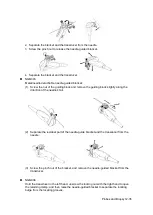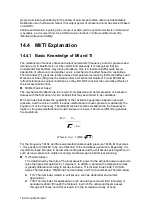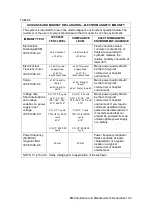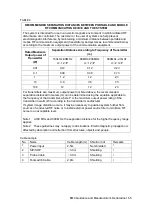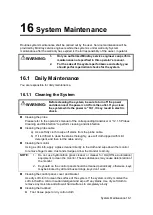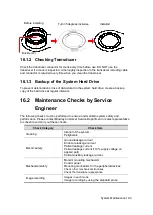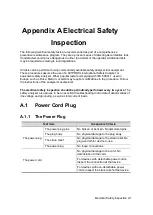
14-4 Acoustic Output
characterization-Test methods for the deter mination of thermal and mechanical indices
related to medical diagnostic ultrasonic fields.
14.6 Acoustic Power Control
The qualified operator may use the system controls to limit the ultrasound output and to
adjust the quality of the images. There are three categories of system controls relative to
output. They are controls that have direct effect on the output, controls that indirectly control
output and controls that are receiver controls
.
Direct Controls
It is possible to control, if necessary, the acoustic output with the menu control. In this case,
the maximum value of the acoustic output never exceeds an MI of 1.9, TI of 6 and an I
SPTA.3
of 720 mW/cm
2
in any mode of operation.
Indirect Controls
The controls that indirectly affect output are many imaging parameters. These are operating
modes, frequency, focal point positions, image depth and pulse repetition frequency (PRF).
The operating mode determines whether the ultrasound beam is scanning or non-scanning.
Thermal bioeffect is closely connected to M mode.
Acoustic attenuation of tissue is directly related to transducer frequency.
The focal point is related to active aperture of transducer and beam width.
For the higher PRF (pulse repetition frequency), the more output pulses occur over a period
of time.
Receiver Controls
The receiver controls (for example, gain, dynamic range, and image post-processing, etc.)
do not affect output. These controls should be used, when possible, to improve the image
quality before using controls that directly or indirectly affect output.
14.7 Acoustic Output
14.7.1 Derated Ultrasonic Output Parameters
In order to determine the relevant Ultrasonic Output Parameters, a method is used which
allows for the comparison of ultrasound systems which operate at different frequencies and
are focused at different depths. This approach, called "derating" or "attenuating", adjusts the
acoustic output as measured in a water tank to account for the effect of ultrasound
propagation through tissue. By convention, a specific average intensity attenuation value is
used, which corresponds to a loss of 0.3 dB/cm/MHz. That is, the intensity of ultrasound will
be reduced by 0.3 dB/MHz for every centimeter of travel from the transducer. This can be
expressed by the following equation:
)
10
/
3
.
0
-
(
10
z
f
water
atten
c
I
I
Where I
atten
is the attenuated intensity, I
water
is the intensity measured in a water tank (at
distance z), fc is the center frequency of the ultrasound wave (as measured in water), and z
is the distance from the transducer. The equation for attenuating pressure values is similar
except that the attenuation coefficient is 0.15 dB/cm/MHz, or one-half the intensity coefficient.
The intensity coefficient is double the pressure coefficient because intensity is proportional to
the square of pressure.
Summary of Contents for DP-50 Exp Vet
Page 2: ......
Page 34: ...2 6 System Overview 2 6 Introduction of Each Unit Right View Left View...
Page 42: ......
Page 68: ......
Page 128: ......
Page 148: ......
Page 166: ...10 18 DICOM For details on tast manager see 9 6 Animal Task Manager...
Page 180: ......
Page 220: ......
Page 224: ......
Page 236: ......
Page 242: ......
Page 248: ......
Page 342: ...D 2 Printer Adapter Type Model SONY X898MD...
Page 343: ...P N 046 017713 02 1 0...


